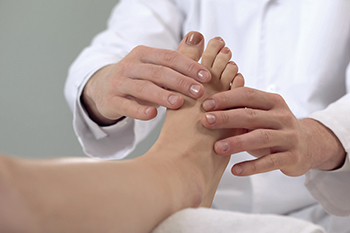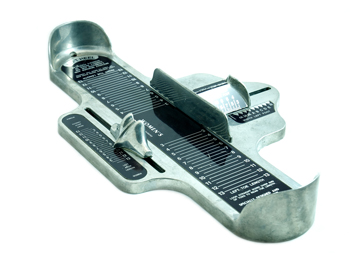

The tarsal tunnel is a structure within the foot that runs along the ankle bones and protects the posterior tibial nerve. When this nerve becomes squeezed and exposed to pressure, a condition known as tarsal tunnel syndrome (TTS) can develop where the nerve is compressed within a small space. Activities that can cause the tibial nerve to become compressed include spraining one’s ankle because such an injury can sometimes produce swelling around the nerve. Certain types of diseases, like diabetes, can sometimes cause TTS because diabetics can experience swelling of the feet, which may put pressure on the tibial nerve. Additionally, the presence of abnormally sized structures within the tarsal tunnel can also cause TTS. For example, large veins, cysts, bone spurs, or swollen tendons can put pressure on the tibial nerve. If you believe that you have TTS, contact a podiatrist today to schedule an appointment.
Tarsal tunnel syndrome can be very uncomfortable to live with. If you are experiencing tarsal tunnel syndrome, contact Dr. Larry Cohen of New York City. Our doctor can provide the care you need to keep you pain-free and on your feet.
Tarsal Tunnel Syndrome
Tarsal tunnel syndrome, which can also be called tibial nerve dysfunction, is an uncommon condition of misfiring peripheral nerves in the foot. The tibial nerve is the peripheral nerve in the leg responsible for sensation and movement of the foot and calf muscles. In tarsal tunnel syndrome, the tibial nerve is damaged, causing problems with movement and feeling in the foot of the affected leg.
Common Cause of Tarsal Tunnel Syndrome
The Effects of Tarsal Tunnel Syndrome
A physical exam of the leg can help identify the presence of tarsal tunnel syndrome. Medical tests, such as a nerve biopsy, are also used to diagnose the condition. Patients may receive physical therapy and prescriptive medication. In extreme cases, some may require surgery.
If you have any questions please feel free to contact our offices located in Midtown, Manhattan New York, NY . We offer the newest diagnostic and treatment technologies for all your foot and ankle needs.

An ankle fracture means that one or more of the medial, lateral, or posterior malleolus (the bony projections on either side of the ankle) is broken. Dislocation of the ankle joint can result from an ankle fracture. Usually, when a patient breaks an ankle, they will experience pain, swelling, and an inability to bear weight on the affected foot. There may be a pop when the ankle breaks, and it may appear deformed. Those with osteoporosis, a history of frequent falls, or a compromised vascular system are more at risk for ankle fractures, as are those who have frequently participated in sports. An X-ray, CT scan, or MRI will confirm a broken ankle diagnosis. If you think you have broken your ankle, it is suggested that you see a podiatrist who can recommend the best treatment options for you.
Broken ankles need immediate treatment. If you are seeking treatment, contact Dr. Larry Cohen from New York City. Our doctor can provide the care you need to keep you pain-free and on your feet.
Broken Ankles
A broken ankle is experienced when a person fractures their tibia or fibula in the lower leg and ankle area. Both of these bones are attached at the bottom of the leg and combine to form what we know to be our ankle.
When a physician is referring to a break of the ankle, he or she is usually referring to a break in the area where the tibia and fibula are joined to create our ankle joint. Ankles are more prone to fractures because the ankle is an area that suffers a lot of pressure and stress. There are some obvious signs when a person experiences a fractured ankle, and the following symptoms may be present.
Symptoms of a Fractured Ankle
If you suspect an ankle fracture, it is recommended to seek treatment as soon as possible. The sooner you have your podiatrist diagnose the fracture, the quicker you’ll be on the way towards recovery.
If you have any questions, please feel free to contact our offices located in Midtown, Manhattan New York, NY . We offer the newest diagnostic and treatment technologies for all your foot care needs.

Shoes may not feel comfortable and can lead to uncomfortable foot conditions if they are not the right size. That’s why getting the right shoe size can make it easier to complete daily activities. Research has indicated that approximately half of adults are wearing shoes that do not fit correctly, and this may be from the lack of knowledge of how to properly buy shoes. It is beneficial to shop for shoes at the end of the day, when the feet are at their largest. Additionally, it can help to wear the socks that would be worn with the shoes, and this may ensure a better fit. There are various methods of determining your correct shoe size. Many people choose to use the Brannock device which is found in the majority of shoe stores. There are some people who find it effective to place their foot on a piece of paper, and trace the outline of their foot. This is followed by measuring the outline with a ruler, and this will provide an approximate size by using a conversion chart. The width of the foot is just as important to measure as the length, and must be taken into consideration for a proper fit. If you have additional questions about how to measure your foot to purchase the correct size shoes, please address your concerns with a podiatrist who can provide the information that you require.
Getting the right shoe size is an important part of proper foot health. Seek the assistance of Dr. Larry Cohen from New York City. Our doctor will provide the care you need to keep you pain-free and on your feet.
Getting the Right Shoe Size
There are many people who wear shoes that are the incorrect size, negatively affecting their feet and posture. Selecting the right shoes is not a difficult process, so long as you keep several things in mind when it comes to choosing the right pair.
As our feet hold our body weight and keep us moving, it is important to treat them right. Picking the right pair of shoes can provide your feet comfort and mobility without pain.
If you have any questions, please feel free to contact our offices located in Midtown, Manhattan New York, NY . We offer the newest diagnostic and treatment technologies for all your foot care needs.

There are a number of foot conditions that you may encounter at one point during your lifetime. Some of them involve the formation of certain abnormal bony protrusions that can cause pain or discomfort. One such foot condition involving a bony protrusion is known as a bunion. Bunions typically develop on the side of the big toe, and in some cases, bunionettes might form on the smallest toe. Since bunions can be an annoyance to those afflicted by them, bunion formation and its causes are of the utmost importance. Bunions are commonly caused by ill-fitting footwear that makes the toes crowd together. Whenever an individual puts a significant amount of pressure on their big toe joint for an extended period of time, this can also potentially lead to bunion formation. Having other conditions or diseases might also lead to bunion formation. For example, having rheumatoid arthritis, cerebral palsy, and Down syndrome makes one particularly vulnerable to developing a bunion. After a bunion forms, it can cause soreness at the affected area or even swelling around the big toe joint. If you believe that you might be at risk of developing a bunion, contact a podiatrist who can help you either prevent or treat a bunion.
If you are suffering from bunion pain, contact Dr. Larry Cohen of New York City. Our doctor can provide the care you need to keep you pain-free and on your feet.
What Is a Bunion?
Bunions are painful bony bumps that usually develop on the inside of the foot at the joint of the big toe. As the deformity increases over time, it may become painful to walk and wear shoes. Women are more likely to exacerbate existing bunions since they often wear tight, narrow shoes that shift their toes together. Bunion pain can be relieved by wearing wider shoes with enough room for the toes.
Causes
Symptoms
In order to diagnose your bunion, your podiatrist may ask about your medical history, symptoms, and general health. Your doctor might also order an x-ray to take a closer look at your feet. Nonsurgical treatment options include orthotics, padding, icing, changes in footwear, and medication. If nonsurgical treatments don’t alleviate your bunion pain, surgery may be necessary.
If you have any questions, please feel free to contact our offices located in Midtown, Manhattan New York, NY . We offer the newest diagnostic and treatment technologies for all your foot care needs.